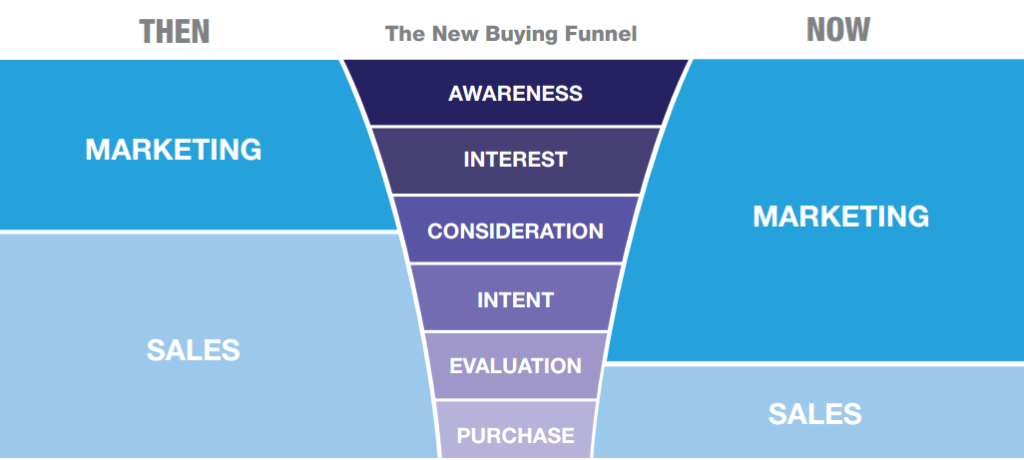By James Kwon
It’s probably about time to reset and relaunch your sales and marketing strategies.
Check out our sales playbook!
01/22/2019
By James Kwon
Despite large investments in sales CRM and marketing automation technologies, the adoption of inbound marketing, and all the hype around sales enablement, c-level execs are still scratching their heads over the level of disconnect between sales and marketing. The number one question now on their minds is “where’s the ROI from these two departments?”
If you, like many of the c-suite execs we know, are looking to see measurable ROI from your sales and marketing efforts then it’s time to go beyond alignment to achieve true sales and marketing integration, a.k.a. ‘smarketing’ — the ultimate state of marketing and sales nirvana. In fact, sales and marketing integration can lead organizations to become 67% better at closing deals and to see a 209% increase in revenue from marketing, according to a study by Marketo.
So how exactly is this achieved? In this blog we’ll cover some potential challenges, considerations, and steps you can take to achieve true sales and marketing integration and drive the ROI you have been seeking.
At the crux of the ROI issue is sales and marketing disconnect. The common causes being an overall lack of communication, bandwidth, standardized processes, common metrics, and accountability measures. We’ve found that following these 6 steps have helped to transform sales and marketing teams within our client’s organizations — resulting in increased revenue from sales and a measurable contribution to ROI from marketing.
The sales and marketing landscape is shifting and digital marketing is at the forefront of this movement.
“B2B, eBusiness, and channel strategy professionals must radically transform their historical sales models to accommodate a real-time and global buying environment where websites, not salespeople, are at the heart of how B2B companies buy and sell.” (Forrester, 2015)
To facilitate this change:
If your sales and marketing team does not have standardized processes in place, your company is probably leaking potential revenue. The lack of standardized processes, common language, and lead protocols often leads to prospects becoming lost in the marketing and sales funnel. In fact, due to the chaos and confusion surrounding funnel stage ownership, 36% of marketing generated leads are never even called according to Forbes. Having a standard process helps to streamline your sales and marketing efforts, eliminate role and task overlap, and creates funnel transparency. Here are three key tasks that can help you begin to define this process:
Marketing and sales tend to see the customer journey through very different lenses. This fragmented vision of the prospect/customer lifecycle often leads to confusion over the marketing-to-sales handoff, overlapping responsibilities, and lost revenue. In order to truly understand the ‘big picture,’ sales and marketing must work closely together to identify buying behavior and define the role each party plays in guiding the buyer through their journey.
The New Buying Funnel:
 Source: https://www.marketo.com/marketing-and-sales-alignment/
Source: https://www.marketo.com/marketing-and-sales-alignment/
Why is a brand story so important? When a company has a clear and unique brand story it can provide a strategic-framework for decision-making. In order to move towards a unified team, put your why into words and:
A brand story translated and distributed digitally has the power to bring companies and prospects together. The challenge is that the modern B2B buyer can reach the decision stage of their journey without ever contacting or speaking to a salesperson thanks to the wonderful world wide web. The key to engaging and influencing these prospects along their buyer journey is in the content.

Source: https://sleeknote.com/blog/keyword-mapping
Through highly targeted content mapped to the buyer journey and skillfully distributed through inbound and outbound channels your sales and marketing teams can become a revenue generating powerhouse.
One of the most critical steps to smarketing, is implementing accountability measures and feedback loops. For a team to be truly integrated, each party must be held accountable for their role in the sales process. The best method for accomplishing this is to develop and document a SLA (service level agreement) between sales and marketing that defines the expected outcomes of the sales process and details both qualitative and quantitative goals. Once the terms are agreed upon by both parties, it is essential to hold regular smarketing meetings in order to build trust, optimize sales and marketing efficiency, and identify any gaps in the pipeline in order to ensure prospects are nurtured from the top of the funnel all the way through to a closed deal.
At Figmints, we have experienced the power of smarketing first hand, for ourselves as well as for our clients — getting both teams to work together to focus on driving revenue.
Bottomline, there are very few companies that have the skillset and bandwidth to do every portion of what is necessary on the smarketing journey. Understanding where the gaps are is the first part of seeing the ROI from both department’s efforts.
At Figmints, we are on a mission to redefine marketing and make it work for sales through our proprietary SalesAmp process. We are more than just a digital marketing and creative agency. We are revenue-focused agency that combines everything you know about marketing [outbound, inbound and digital marketing] and combines that with inside sales support. Through this process, Figmints identifies and navigates gaps in your pipeline to ensure prospects are nurtured from the top of the funnel all the way through to a closed deal.
Intrigued? Let’s connect to see how SalesAmp could work for your company.
When we first started working with Community Teamwork, we saw a lot of opportunities for their brand.
Uncategorized
One of our latest projects was “Axis AV,” but that wasn’t always its name.
Branding
10 Cool Things on the Internet Every Two Weeks
Native Creative